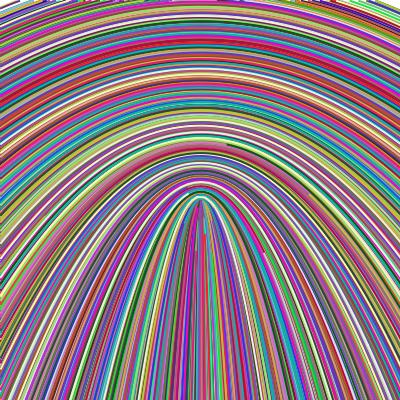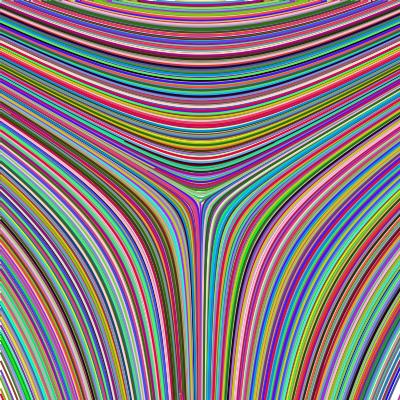Nematic liquid crystals are soft matter systems in which elongated molecules align and form long-range oriented fields, in 2 or 3 dimensions. They have a long history, many practical applications, and are increasingly recognized for the many roles they play in biology. In a recent paper [Phys. Rev. E 102, 012607 (2020)], my former visiting student Yiheng Zhang (张一恒), his supervisor Zhanchun Tu (涂展春), (both at Beijing Normal University, and myself have investigated a particular question involving nematic liquid crystals, namely: what if we put an active version of such a system on the surface of a sphere—how can we efficiently describe what’s going on? Let me unpack what this question even means.
The local “director field” of liquid crystals tends to be nice and smooth, but it is possible that a little “defect” sneaks in. For instance, the two pictures below show a +1/2 and a –1/2 defect, where locally the smooth field is disturbed. The number “+1/2” means the following: if you walk around the defect in a circle, say counterclockwise, then the local direction of the field also rotates, but it only rotates half way around, by 180 degrees, while you do a full turn, 360 degrees. For “–1/2” you also get a half rotation, but the field rotates in the opposite direction in which you traverse the circle: if you go around counterclockwise, the field rotates clockwise.

A +1/2 defect in a nematic liquid crystal.

A –1/2 defect in a nematic liquid crystal.
The fun bit is that these defects cannot be “locally removed”: there is no way to turn the molecules a bit at the center of that cowlick and get rid of the defect. The defect is “topological”. Its presence is encoded in the entire field. But the reverse is also true: knowing the defects, you also know the field! (At least its minimum energy configuration.)
That’s a bit like saying that charges determine the electrostatic field, and conversely, the electrostatic field can tell us where the charges are. In both cases by Gauss’ law. Even though we typically don’t think of this situation as topological. And just like charges are conserved, so are defects. But wait, we can create charges! We just must also create charges of opposite sign! Well, the same is true for defects. We can create a +1/2 and a –1/2 defect together, locally, and then move them apart to make two individual defects.
All this suggests that a fantastic way to think about liquid crystals is to, well, not think about the actual liquid crystals, but instead to look at the defects. Just like you can think of the electrostatic field by instead just thinking about the charges that make it.
And yes, charges interact via the electrostatic field, and topological defects interact via the elastic deformations imposed on the liquid crystal. The more these curves deviate from simple parallel lines, the higher the elastic deformation energy (called “Frank energy”). And the analogies go on and on. Soft matter physics is incredibly rich in so much beautiful stuff like that.
Back to the paper. We look at such a liquid crystal on the surface of a sphere, and this adds another interesting level of complication, again because of topology. There is a famous theorem due to Poincaré that states you cannot have a smooth everywhere non-vanishing vector field on the surface of a sphere. It’s cockily knows as the “Hairy Ball Theorem”, because it can be summarized thusly: “You can’t comb a sphere without leaving cowlicks”.
But wait: isn’t our nematic liquid crystal a vector field on a sphere? Sort of, almost, and that shows you we’ll run into trouble: There will be cowlicks (sorry, defects!). But since the nematic field is not a vector field but a director field (i.e., orientation does not matter), we can have defects of half integral nature, like the +1/2 and –1/2 images from above. That would not be possible if orientation mattered: if we rotate a vector by only 180 degrees as we transport it around a defect, it would return to the starting point oriented into the opposite direction from the vector it started with. So it’s aligned in direction, but we’re off by a minus sign. If we only care about the direction in the first place, that minus sign is not there.
Topology furthermore states that the sum of all defects needs to add up to 2. (This is because of the Poincaré-Hopf Theorem. Turns out, topology says lots of amazing things!) And this means that our nematic liquid crystal on the surface of a sphere must have at least four +1/2 defects. Actually, it would also be possible to have two +1 defects, but this is a situation that has a higher energy. It would also be possible to have 6 defects of type +1/2, and then to cancel two of the superfluous ones by also adding two –1/2 defects. But again, such a situation would have a higher energy. That means, in its lowest energy configuration, the system will have exactly 4 defects of type +1/2. And you will not be surprised to learn that they’ll sit at the corner of a tetrahedron.
But wait, there’s more! I’m still just summarizing what the ancients knew.
You can now make the system active. Meaning, you can wave a magic wand and then the individual stick molecules will actively try to move pasts one another. Sure, “magic wand” doesn’t sound much like physics. But biology does that all the time. If your nematic field is made from microtubules, and you sprinkle in kinesis motors, and some ATP, the microtubules will push past one another. The field starts to move on its own!
What do the defects do? Well, they will of course also move. More precisely: the +1/2 defects will move on their own (the one in the picture above will move upwards), but the –1/2 ones will not! (They just get passively shoved around, while then +1/2 actively zoom along.) As a consequence, the whole liquid crystal field gets stirred around, and incredibly complex motion happens. It looks like salt water taffy being pulled. Or turbulent flow lines in a liquid. Even though (for the expert) this all happens at vanishingly small Reynolds number!
Now imagine you want to describe that. You have a partial differential equation for the field, and active driving forces. Forget analytics. This goes onto a computer! But even then it’s hard: those PDEs take a lot of effort and computing power to solve! But haven’t I told you that the field determines the defects, and the defects determine the field? If I want to understand the motion of a bunch of electrons, I don’t solve Maxwell’s equations. I solve the motion of a few particles subject to Coulomb forces!
This is what Yiheng and Zhanchun set out to do: find equations of motions for the defects, as they actively zoom about. This should be possible, and it had been looked into for planar liquid crystals. But spheres are more complicated. And much more interesting!
There’s some technical beauty here, e.g. how to use a variational principle to get equations of motions in dissipative thermodynamic systems (“Minimize the Rayleighian!”), and you should look at it. But I’ll skip that for this summary. Long story short: Yiheng found these equations. And he can therefore look at the motion of defects, e.g. as a function of how strong the active driving force is.
For weak forces, nothing moves. Push the gas pedal a bit more, and you suddenly get rather intricate periodic motions. The four +1/2 defects execute a very beautiful periodic dance around each other. More gas and, boom, chaos!
What I find most fascinating is where this could ultimately lead. Recall that defects behave pretty much like charges, they are conserved, but they can be created and destroyed in pairs. Does that remind you of something? Quantum Electrodynamics maybe? Yes, what we have here is really a field theory in which the elementary excitations can be pair created and annihilated, like electrons and positrons in QED. But the underlying field is much more complicated, so a lot more fun stuff could happen.
Notice in particular that, in QED parlance, the “vacuum” on the sphere is crazy: It is never empty, because you cannot get rid of all defects (topology!). And it is never quiescent, because the +1/2 defects zoom about when active.
That’s one hell of a field theory to ponder. And Yiheng’s paper did the first step: we have the equations of motion for those defects. But so much more needs to be done. If High Energy Theory is not exotic enough for you, welcome to Soft Matter Physics!

Markus Deserno is a professor in the Department of Physics at Carnegie Mellon University. His field of study is theoretical and computational biophysics, with a focus on lipid membranes.

0 Comments